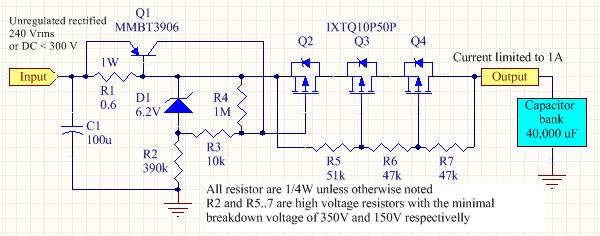This Design Idea presents a simple, proven, reliable, and robust method for charging large capacitor banks, using a series connection of power MOSFETs to raise the breakdown voltage over that of an individual MOSFET.
When a power supply drives a large capacitive load, inrush current, if not limited, can reach tens or hundreds of amps for a high voltage power supply. In general, maximal ratings of a power supply could be transiently exceeded by many times, but this is generally acceptable when the transient lasts a few AC-line cycles. This is typical for load capacitances up to a couple of hundred microfarads, but for load capacitances in thousands of microfarads, an inrush current limiter is a must. Using MOSFETs as voltage controlled current elements is very suitable to capacitor-charging circuit design. Consider though: If a task specifies charging a capacitor bank with 1A from rectified AC mains of 240V, a design with a single P-MOSFET would require that at power-on, the MOSFET pass 1A when its drain-to-source voltage |VDS| is about 330V, which exceeds the safe operating area of most parts.
For more detail: Series-connected MOSFETs increase voltage & power handling

